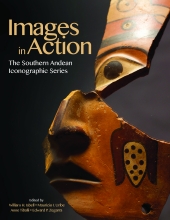Visual database
Embroidered borders in Ocucaje 9 and 10 styles, executed in dyed camelid hair on tightly woven, slightly warp-faced cotton base cloth, probably fragments of two mantles. TM 91.1032, TM 91.901.
Mantle with full figures embroidered on the borders in the Ocucaje 10 Style, with the addition of large rayed head figures in different yarn weight, dyes, and stitching in the central area of the plain-weave panel. This textile is ascribed to a Nasca 1 Burial at Ocucaje. TM 91.906.
Paracas Necropolis Burial 420, Specimen 3. This very early Block Color embroidery, a detail of a rectangular tab hanging down the back of a shoulder poncho, shares design features with Broad Line, Linear, and early Nasca embroideries. It is worked on a woven panel, with a simple contrasting fringe. MNAAHP RT2999.
Paracas Necropolis Burial 243, Specimen 7. This early Block Color-style embroidered mantle border depicts a human wearing a sheet gold forehead ornament, mouthmask, and disks attached to a headband and carrying a knife and human head tassel. The rayed headdress incorporates the tail of a "goatsucker" figure. This image is repeated on a matching shoulder poncho. MNAAHP RT3173.
Paracas Necropolis Gravelot 420, Specimen 2. This detail from a complex figure shows a human-bird figure that tips a long appendage that emerges like a tongue from the mouthmask of the main figure. This secondary figure in turn has a mouth appendage ending in a feline and holds a sling or necklace in one hand and a forehead ornament in the other, with a rayed head in the position of a headdress ornament. MNAAHP RT5907.
Paracas Necropolis Burial 421, Specimen 44. Detail of the neck of a shoulder poncho (esclavina) with borders and bands depicting interlinking bands attached to rayed heads. Felines are set into the triangular interstice. Note the tiny rayed motifs in the subborder. MNAAHP RT205.
Examples of rayed head figures on a headcloth and mantle from two related gravelots from the Wari Kayan cemetery (Paracas Necropolis) demonstrate similarities and differences on the levels of garment design, figure style, and iconography. (a) Paracas Necropolis Gravelot 310, Specimen 39, MNAAHP RT1003. (b) MNAAHP Gravelot 378, Specimen 7. RT2673.
Border fragment combining several different figures, including one with a mask-like rayed head, embroidered using techniques, design principles, and a range of colors characteristic of early Nasca. AMNH 41.2 714.
Mantle combining an image similar to late objects from Paracas Necropolis gravelots on the central band, imagery, and design features associated with contemporary objects of Nasca Valley provenience on the lateral borders and a repetition of rayed head images across the central ground. AMNH 41.0 1501.
Headcloth with rayed head motifs worked in camelid hair using a warp wrapping technique during the weaving of the fine cotton cloth of the central panel. A separately constructed border carries designs constructed in complex looping over separately woven cotton plain-weave tapes and knotted extensions. Small embroidered motifs resembling hummingbirds with looped elements span the join between the borders and the central panel. BMA 38.121.

